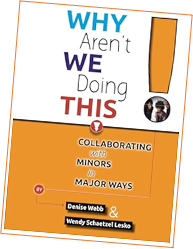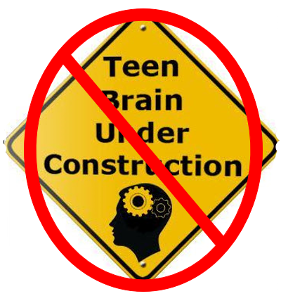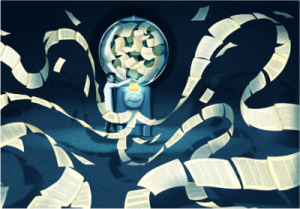At a time when many make self-satisfied gestures at the notion of “alternative facts” that it looks like we’ll be living with for the next four years, I’d like to point out that we’ve come to live with a few alternative facts of our own.
A branch library I served at during the early 1990s attracted the patronage of a young man named “Rubin.” He was about fourteen then–the peak age identified by teachers, librarians, developmental psychologists, and administrators for “teen behavior problems.” From that point of view, Rubin might well have been labeled, incessantly hawked over, and routinely expelled from the library. This is an actual fact that happens every day.
The point I want to emphasize, though, is that there is no such thing as “teen behaviors.” This is an “alternative fact.”
“Teen behaviors” is just a cliché, a synonym, for staff who don’t understand, or know how to build relationships with others who don’t match prescribed and over-determined expectations.
Ruben was stretching and exploring his social environment when visiting the library. Who would accept him? Who would toss him aside? This is an actual fact of social life.
Here’s how this story developed. I asked him his name. I asked him who his favorite teacher was and acted like I knew her (“Oh, yeah. Ms. Patton, at Belmont, sure, I know her . . .”). When he asked me, I told him my girlfriend’s name. I gave him his own library nickname, “Screech,” (after the nerdy character in Saved by the Bell–the 1980s/90s TV sitcom—though he was certainly not a nerd–whatever that is!). I introduced him to e-mail and early online chat (remember this was early-90s!). Then I made fun of the people he thought he was communicating with when he was online chatting and flirting. He hated me for that! J
During this time, Ruben began to experiment with profanity. Not an uncommon fact.
Suddenly, everything was F… this and S… that.
Staff descended on him.
Frankly, I think that some staff came down on Ruben harder because he and I had developed a relationship–this was a cynical opportunity to prove that my approaches were naïve. This was not only an alternative fact. It was also counterfactual.
When I was not around, Ruben was expediently ejected from the library upon the inevitable next profanity infraction.
Adults use profanity all the time in the library. No ejection there. Fact.
Even before I’d encountered educator Ruby Payne, who has produced spectacular contributions to the work professionals do with clients from intergenerational poverty, I knew Ruben was reaching to broaden his horizons. His cursing was indeed selective and strategic (not compulsive) . . . he did it to express his growing power, familiarity, and comfort within our little library community.
One day I told him that I needed him to “help me do some stuff” and asked for his assistance. I invented a few tasks for him to do while I was on the reference desk . . . and told him that he needed to be within ear-shot of me while I was serving on the desk.
I wanted him to observe my interactions with library users.
After about an hour I took him aside. I asked him to evaluate what he observed of my interactions with the public. What did he think of my attitude in serving the people who came up to the desk? Why was I kind of dressed-up (buttoned-down collar on a pressed shirt, ironed slacks, and polished street shoes)? What did he observe of my phone work? What kind of language did I use and why?
Eventually, we got around to how those things were important aspects of serving the community. My language, dress, and manner reflected the respect I both gave and how I was received by library users.
Our interaction went something like this:
Anthony: Do I talk the same way with you that I do with other library users?
Rubin: “No.”
A: Do you think I talk “all polite like that” with my friends?
R: “No.”
A: With my girlfriend?
R: “NO!”
A: “Why?”
R: “Because you know them.”
A: “Right. I talk differently when I am representing the library.”
A: “When you (Rubin) use swear words in your own life you might be just relating casually with your friends or you might be disrespecting the people around you. But you make a choice, don’t you? When you cuss while you are volunteering for the library, though, you tell the public that the library doesn’t respect them. And when you do it around these children you are squandering the role model you represent to them.”
A: “Is this what you want?”
I will not say that Ruben stopped cussing overnight. He didn’t. And that’s a fact. But over the next few weeks, it dropped off to nearly nothing. And that’s a fact, too.
After our discussion, and building on our relationship, he modulated his language himself because he could see the implications and preferred to avoid them in the library.
Is this being a social worker? A psychologist?
No. It’s the kind of explicit and discrete role modeling you hear and read about all the time but rarely see in action. It’s modeling what community-based public service is about. It’s modeling what it means to respect and serve a real and actual community–a factual place and time. It’s modeling these things not simply for one young man who deserved just a little more attention but it’s modeling that behavior perhaps even more significantly for library staff that might otherwise feel entitled to impose their own alternative facts, privileging their alternative facts selectively on the head of young people.
While I don’t have any photos or evidence, you’ll have to just take my word for how this story ended. Ruben became a steadfast volunteer for the branch. He began demonstrating how people could use the computer scanner (new then). He started assisting the computer tutor with word processing instruction for Spanish speakers. He eventually served one-term as my appointed YA volunteer program assistant.
Rubin became, in Ruby Payne’s terms, a “homegrown leader.”
The other option would have been to institute alternative facts and throw him out every day.



